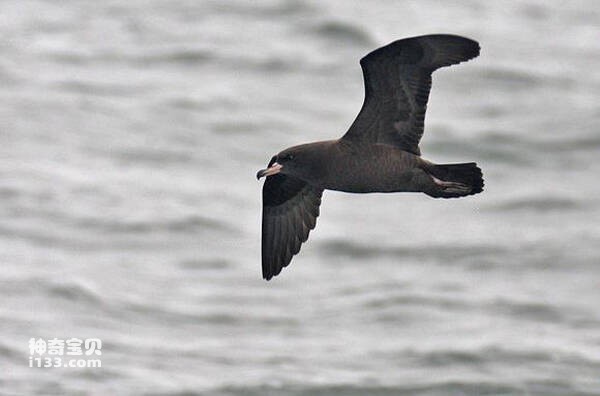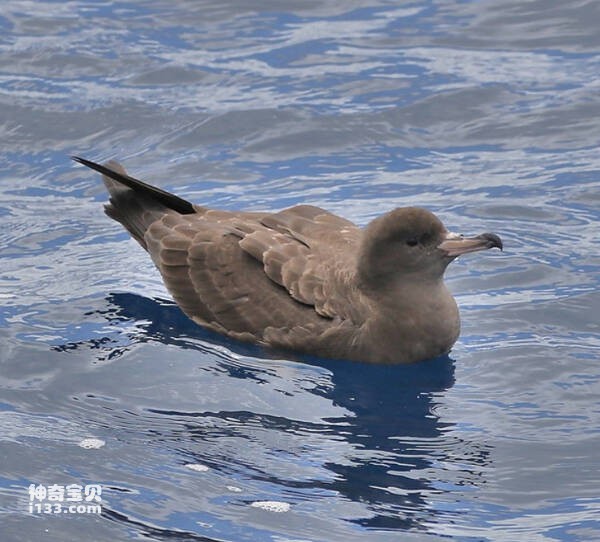Ardenna carneipes
IUCN
LCBasic Information
Scientific classification
- name:Ardenna carneipes
- Scientific Name:Ardenna carneipes,Flesh-footed Shearwater,Puffin à pieds pâles,Pardela negruzca,Pardela paticlara,جلم لحمي القدمين
- Outline:Waterfowl
- Family:
Vital signs
- length:About 45 cm
- Weight:580-765g
- lifetime:About 30 years
Feature
The light-footed shearwater may be confused with the powder-footed Shearwater, but has a darker belly
Distribution and Habitat
The mild-footed shearwater lives in the Indian and Pacific oceans, where the southern coast of Australia and the North Island of New Zealand connect to form the southern limit of their range. In the Pacific Ocean, the northern boundary consists of a fairly straight line that begins at Sakhalin Island and crosses the tip of the Kamchatka Peninsula, connecting the Aleutian Islands to the Alaskan Peninsula. The main nesting sites are: St. Paul (southern Indian Ocean), southwestern Australia, Lord Howe Island (eastern Australia), the small island of New Zealand near the North Island, and Cook Strait New Zealand, which separates New Zealand's two main islands.
The light-footed Shearwater is a unique Marine species that inhabits open ocean and island environments. It occurs mainly on subtropical continental shelves and slopes, but occasionally in nearshore waters. These birds nest in wooded hills, especially those overgrown with shrubs and forests. They also breed on slopes or grassy
Appearance
It is 45 cm long, has a wingspan of 99-107 cm, and weighs 580-765 g. It is a large, broad-winged seabird. It has dark plumage and a strong pale beak. The overall plumage is dark brown, usually darker on the head, neck, upper part of the flight feathers, and tail. The overcoats and upper tail overcoats have brown edges and will have a slightly scaly appearance, which is more pronounced at the shoulder corners. The underside of the feathers is grayer and paler. In some spectra, larger concealers may appear more or less silvery. The abdomen appears paler and has lighter spots than the rest of the lower body.
The iris is black, the beak varies from pink to character, and the tip has a black dot. The legs are pink, and part of the toes are gray. Both sexes have the same plumage, but the male is larger.
Juveniles are similar to adults, but the April-July juveniles are newly feathered, while older birds have worn out or molted.
The light-footed shearwaters that nest in South Australi
Details
Petrel Ardenna carneipes) Flesh-footed Shearwater, Puffin a pieds pales, Pardela negruzca, Pardela paticlara, footed shearwater, footed Shearwater, Puffin a pieds pales, Pardela negruzca, Pardela paticlara, No subspecies. The mild-foot Shearwater (Ardenna carneipes) was classified in the genus Puffinus until 2014.

The light-footed shearwater is a highly migratory species, a migratory bird. Every year from March to September, breeders from Lord Howe Island spend the winter in Korea. The New Zealand population ranges as far north as the Sea of Okhotsk. Some fly to the West Coast of the United States in warm water years. Western Australian populations migrate to the Indian Ocean and the Arabian Sea. They arrive there at the end of May and stay there until August. During migration, in the Pacific Northwest, they descend to a depth of slightly more than 2.50 meters, while at the start of breeding, they are able to reach depths of 8.70 meters.
Light-footed shearwaters are not very social, but they form loose groups and sometimes mix with other species of gulls. The birds often follow fishing trawlers on major sweeps, catching debris that is thrown into the sea. This species is primarily diurnal.

The light-footed shearwaters call from their burrows mostly at night. They also sing on land and in flight; Occasionally during the day. "gug gug gug," followed by a melodious three-syllable call that transforms into "ku-koo-ah." The second part of the sound is repeated five or six times. End with a grunt or crackle that fades away. The three parts are combined to form a song performance lasting about 10 seconds.
Weak-footed shearwaters fish mainly by chase diving, but also dive to depths of up to 5 meters below the surface. The food consists mainly of squid and fish, especially during the breeding season. However, studies conducted over long periods of time in stable environments have shown that these birds also eat soft-bodied non-cephalopod invertebrates. At this time (non-breeding period), the animals found in the digestive tract are mainly Lanternfish of the family Lanternfish or autumn knifefish. Other species of fish have also been found, such as snapper and flying squid.
Light-footed shearwaters breed in pairs on islands in caves on sloping ground in coastal forests, shrubs, or grasslands. The nest consists of an enlarged chamber (1-3 meters long) located at the end of the cave, and the entrance is usually covered with plant material.

Light-footed shearwaters are entirely nocturnal, arriving at their breeding grounds about 30 minutes after sunset. Nesting time begins in late September or early October as the birds return to their habitat. The first eggs are laid between November 20 and December 12, and the chicks hatch in late April or early May. The light-footed Shearwater is a colony, using the same burrows as the grey-faced Shearwater, which is a winter nest builder. They lay their eggs in tunnels 1 to 2 meters long. Each clutch lays 1 white egg, with an average size of 7 cm. The incubation period is about 53 days, and the incubation period on Lord Howe Island is nine days shorter.
The newborn chicks have grey fur and are kept warm for two days before being fed daily by their parents. As we age, the size and number of meals increase, but the frequency decreases. Young birds gain weight rapidly; When they weigh 545 grams, they take off and leave the nest after 92 days.
In search of food during the breeding period, populations in Western Australia go on expeditions, flying as far as 300 kilometres from their birthplace. The Lord Howe Island species make two types of trips, the shortest being less than 3 days and the longest estimated to be more than 3 days. The brood success rate on Lord Howe Island is estimated at 60%. The petrel has a life expectancy of 30 years.
Listed on the IUCN Red List of Threatened Species (IUCN)2018 ver3.1 - Near Threatened (NT).
Protect wild animals and eliminate wild meat.
Maintaining ecological balance is everyone's responsibility!








